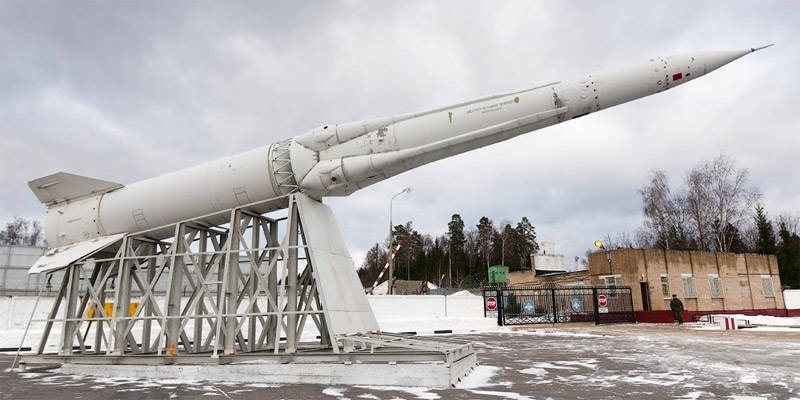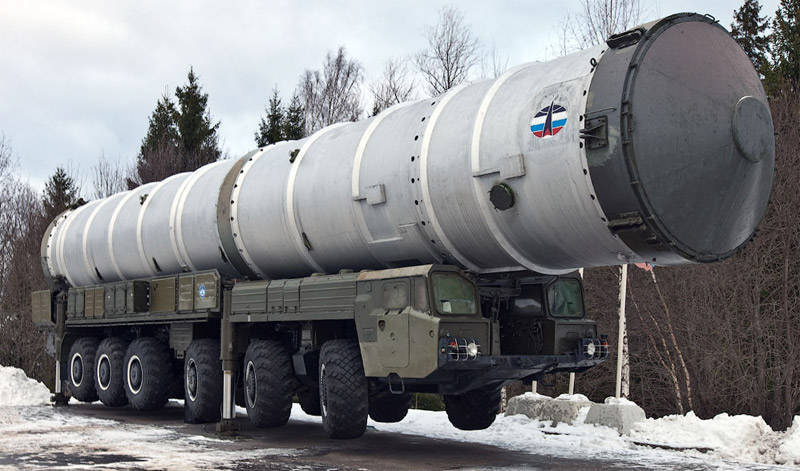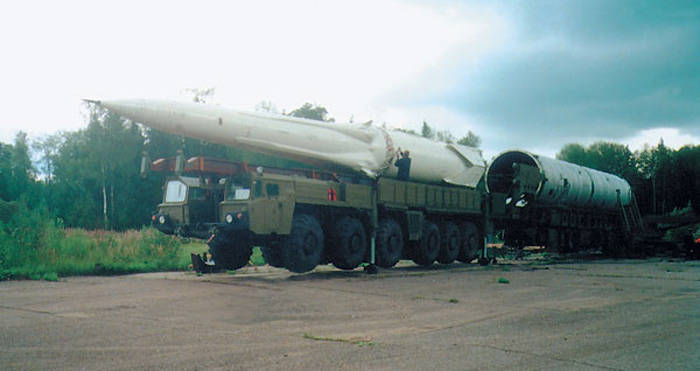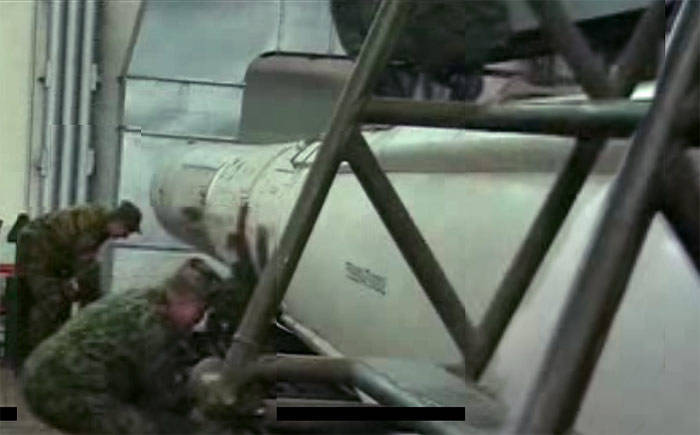Missile defense of Moscow. Part II
In 1972, the USSR and the United States signed an agreement on the limitation of anti-missile defense systems. In accordance with this document, countries had the right to build only two missile defense systems: to protect the capital and the positions of strategic missiles. In 1974, an additional protocol was signed, according to which the Soviet Union and the United States could have only one missile defense system. In accordance with this protocol, the USSR continued to build its defense systems for Moscow, and the United States surrounded the Grand Forks base with anti-missiles. The agreements made it possible to keep up to 100 interceptor missiles in stationary positions at the same time.

Monument with an electric-weight rocket model 51Т6 Pos.Sofrino-1 near Moscow, 28.12.2011 g. (Dmitry, http://da-ck9.livejournal.com)
The signing of an agreement on the limitation of missile defense systems has affected the further development of such systems in two countries. It should be noted that this document had a minimal impact on the plans of the Soviet leadership. The complexity and high cost did not allow the construction of several anti-missile systems other than Moscow, and the treaty completely prohibited their creation. At the same time, since the beginning of the seventies, Soviet scientists and designers have been actively working on the modernization of the Moscow ABM A-35 system.
Preliminary design of the new A-135 ABM Amur was ready at the end of 1971. The project developed by Vympel under the guidance of A.G. Basistova, meant the construction of three shooting systems "Amur", equipped with anti-missile and a set of radar stations. The complexes should have been located at a distance of more than 600 km from Moscow, which would allow timely interception of ballistic targets. In addition, close to the capital, it was proposed to place the C-225 missile systems, designed to become the second echelon of the missile defense system.

The TM-112 transport vehicle with TPK 81Р6 of the rocket 51Т6 of the A-135 missile defense system is installed as a monument to the settlement of Sofrino-1 near Moscow, 28.12.2011 (http://4044415.livejournal.com)
The terms of the agreement on limiting missile defense systems have affected the appearance of the new project. Now it was required to place all system components in a circle with a radius of 50 km centered on Moscow. Until the end of 1973, Vympel prepared the new version of the draft with the corresponding changes. For example, in the updated project it was proposed to abandon the C-225 missiles, and to assign all the tasks of hitting targets to other interceptors. A year later, Vympel employees had to re-finalize the project in connection with the additional protocol to the contract.
As a result of all the improvements, the A-135 project has acquired its final look. The following components are part of the prospective missile defense system:
- The command and computing point 5K80, combining computing facilities and control systems of the anti-missile complex. The basis of computing systems were four Elbrus-1 computers (later upgraded to Elbrus-2);
- Don-2H radar, intended for detecting and tracking targets, as well as for targeting missiles;
- firing complexes with mine launchers for interceptor missiles;
- 51Т6 and 53Т6 rockets.
Perhaps the most well-known component of all missile defense systems in Moscow is the radar station Don-2Н. The structure in the form of a truncated pyramid contains part of the main electronic components of the missile defense system. On each of the four faces of the building are located a rectangular transmitting and a circular receiving antenna. The design of the antennas provides a circular view in azimuth. Radiation power up to 250 MW allows the detection of ballistic targets at a distance (according to various sources) from 1500 to 3500 kilometers. The maximum detection height of a space target is up to 900-1000 km. According to some reports, the Don-2Н radar can accompany more than a hundred complex ballistic targets, the detection of which is hindered by false targets. Radar is also used to control missiles. According to various sources, the number of simultaneously controlled antimissiles varies from a few dozen to 100-120.

Radar "Don-2N" / PILL BOX PRO system A-135, pos.Sofrino-1, 28.12.2011 (author of the photo - Leonid Varlamov, http://mmet.livejournal.com)
The basis of the command-computing point 5K80 was originally a computer "Elbrus-1". This system made it possible to process information from the Don-2 radar, track ballistic and space targets, and determine their priority. The command-computing point is capable of automatically performing all operations, incl. launch anti-missile systems and control their guidance.
As a means of hitting targets in the A-135 “Amur” complex, two types of missiles were used: 51Т6 and 53Т6. The first of them was built on a two-stage scheme and equipped with engines of various types. At the first stage a solid-fuel engine was used, at the second - a liquid engine. According to some information, the second stage of the 51Т6 rocket used the same engine as the А-350 rocket of the А-35 complex. The anti-missile 51Т6 had a total length of about 20 meters and a starting weight of 30-40 tons (in different sources different figures are given). The range of the rocket is estimated at 350-600 kilometers. For reliable destruction of the target, the 51Т6 rocket was equipped with a nuclear warhead. The task of this interceptor missile was to destroy ballistic targets at high altitudes.
The 53Т6 rocket is intended for hitting ballistic targets after they enter the atmosphere. The high-speed rocket 53Т6 has an original design: its body is made in the form of an elongated cone. The rocket is equipped with a solid-fuel engine that provides flight speed at the level of 3500-4000 m / s (according to other data, at least 5 km / s). The launch mass of the 53Т6 rocket exceeds 9,6 tons. Total length - about 12 meters. According to various sources, the anti-missile system is capable of destroying targets at a distance of up to 100 km and an altitude of up to several tens of kilometers. Warhead - high-explosive fragmentation or nuclear.
The missiles of both types were completed with a transport and launch container, with which they were placed in the launch shaft. To control the missiles in flight, the radio command system is used. In this case, the on-board equipment of the products allows you to continue flying with the loss of a control signal, although in this case the effectiveness of the attack of the target significantly decreases.
In 1976, the construction of a prototype A-135 system began at the Sary-Shagan test site. As before, it was proposed to test the operation of the systems with the help of the complex in a reduced configuration. The Amur-P range test station included the Don-2NP radar, the command-computing point 5K80P and a missile firing complex. Installation of all components of the complex continued until the 1978-79 year. Soon after the work was completed, the tests started. Testing of the A-135 test site system continued until the 1984 year, and from the 82, work was carried out as part of factory test sites. In total, several dozen launches of interceptor missiles were conducted. In addition, tests were conducted radar "Don-2NP", during which the station monitored ballistic targets and artificial satellites of the earth.
At the end of the factory tests at the test site, the installation of new systems began, primarily the Elbrus-2 computer. From the autumn of 1987 to the end of the summer of 1988, the Amur-P missile defense system monitored conditional targets and carried out test interceptions of ballistic missiles. This stage of testing confirmed its characteristics.

Installation of the 51Т6 rocket in TPK 81Р6, Moscow Region (http://www.ljplus.ru)
Construction of new facilities in the Moscow region began in the mid-eighties. By the end of the decade, all the necessary facilities were ready. In 1989, state trials began. According to some information, state tests of antimissiles at the same time were conducted at the Sary-Shagan test site. The A-135 system confirmed all its characteristics and at the very end of 89 was recommended for use. Trial operation of the complex began in about a year.
At the beginning of 1991, the A-135 system took over experienced combat duty, and within a few months the deliveries of the required number of interceptor missiles were completed. Over the next few years, due to the difficult situation in the country, Moscow’s missile defense system experienced serious problems of a different nature. The official adoption of the A-135 system took place only in 1996 year.
The A-135 “Amur” ABM system has been in operation up to the present. The details of her work for obvious reasons are not covered. It is known that in the middle of the last decade the 51Т6 rocket was decommissioned, which is why the only means of defeating the complex are products of the 53Т6 type. In recent years, there have been repeated reports of 53Т6 missile test launches at the Sary-Shagan test site. The purpose of these tests is to check the performance weapons. The exact number of missiles in service is unknown. According to various estimates, after the cessation of mass production (1993 year), several hundred interceptors remained on the bases.
A-235
At the end of the seventies, shortly after the end of the main design work on the A-135 project, the Council of Ministers issued a resolution on the creation of a new system of a similar purpose. The document required to develop and build a promising missile defense system capable of supplementing, and then replacing, obsolete complexes. The head company of the program was again appointed by the Vimpel Central Scientific Industrial Association, and later this status was transferred to the Scientific-Research Institute of Radio Instrument Engineering (NIIRP). Unfortunately, there is very little information about this project. In addition, some of the information is the assumptions of specialists on the basis of available information. However, it is possible to get a rough idea of the A-235 system being created now.
According to some information, a new missile defense system called A-235 was supposed to be built according to a two- or three-echelon scheme using several types of interceptor missiles. When creating a new ammunition should have been used developments in previous projects. Work on this version of the project, most likely, was in the first half of the eighties.

Presumably on the frame, either full-scale BRUTS-B field work with the 51Т6 rocket or, possibly, one of the prototypes of long-range missiles of the A-235 / ROC Samolet-M system, October-November 2007 (a frame from the film Vadim Starostin, http://video.mail.ru/mail/vaducha61/)
At the very beginning of the nineties, development work began on the subject “Samolet-M”, the purpose of which was the profound modernization of the newly constructed А-135 system. According to some data, in the future, the staff of NIIRP and related organizations were engaged in the development of promising systems, and also used the existing facilities at the Sary-Shagan test site. Details of the work are unknown.
From the available information, it follows that the main objective of the “Samolet-M” project is to upgrade existing types of interceptor missiles in order to improve their characteristics. This assumption can be confirmed by a test launch of the 53Т6 rocket at the end of the 2011 year. According to media reports, this rocket was equipped with a newly manufactured engine, and the launcher and ground equipment of the Amur-P test range underwent some modifications.
If the assumption of creating a layered missile defense system is true, then in the future new types of interceptor missiles may appear (or have already appeared, but this has not yet been announced). In addition to the existing 53Т6 antimissiles, a product with a large firing radius can be created to replace the decommissioned 51Т6 missile. In addition, it is possible to develop a short-range missile, the task of which will be the destruction of targets that have managed to break through the previous two defense echelons.
It is safe to talk about the upcoming modernization of the existing ground elements of the A-135 system. After upgrading, the existing radar station Don-2Н and the command-computing center will be able to get new opportunities corresponding to the updated weapons. Do not exclude the possibility of building new facilities of similar purpose.
All work on the subject "Samolet-M" / A-235 is conducted in an atmosphere of strict secrecy and to date only a few pieces of information have become publicly available. For this reason, the current status of the project remains unknown. The project may be terminated or is ready to conduct field tests. It is possible that over the next few years or even months, developers and the military will publish the first information about the latest project, which will allow to make sufficiently fair estimates.
***
The development of domestic missile defense systems started in the fifties of the last century and continues to the present. During this time, scientists and engineers have created and built several dozen different components of missile defense systems: radio-electronic systems, interceptor missiles, various structures, etc. In addition, a separate mention worthy of experienced systems at the Sary-Shagan test site. All these titanic efforts led to the emergence of a unique missile defense system protecting Moscow.
Since 1971, the Soviet Union and then Russia have a system that allows them to detect an enemy ballistic missile in a timely manner and destroy it on the way to the capital of the state and the surrounding areas. Over the past forty years since then, three systems with different types of equipment and weapons have been on duty - А-35, А-35М and А-135. In the future, the new A-235 complex with even higher performance should appear. The emergence of this system will allow maintaining an effective antimissile “umbrella” over Moscow for the next few decades.
On the materials of the sites:
http://pvo.guns.ru/
http://priozersk.com/
http://old.vko.ru/
http://militaryparitet.com/
http://popmech.ru/
http://militaryrussia.ru/blog/topic-354.html
Information